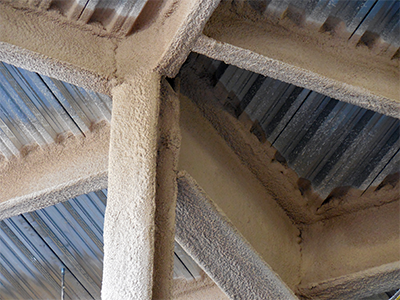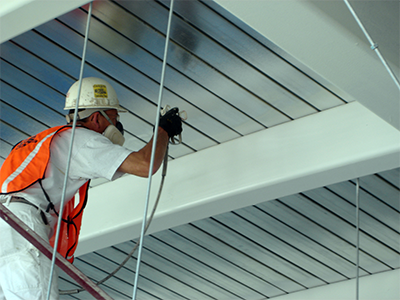Commercial and Residential Fireproofing: Spray-Applied and Intumescent Fire Resistive Materials
KC Spray Foam & Coatings, LLC is an Spring Hill, KS based company that specializes in commercial and residential fireproofing. We focus on Spray-Applied and Intumescent Fire Resistive Materials for your fireproofing needs. Since we are in Spring Hill, KS, we proudly serve the states of Missouri and Kansas, focusing on the 80-mile service area around Kansas City. However, we will travel further for larger fireproofing projects.
Fireproofing is crucial to any building whether it be residential or commercial. Fireproof ratings usually come in hourly ratings, usually somewhere between 1-4 hours. What this means is that the fire proofing material must protect the building materials for the given hour rating to allow the firemen time to get people out of the building safely. The hourly rating depends on many factors such as, height of the building, use of the building, and how close the building is to other buildings.
Fireproofing is commonly found on structural steel framing, columns, beams and floor decking. Keep in mind that steel framing can lose over half its strength once it reaches 1,000 degrees. So, if there is a fire, think about all the weight of the building above pushing down on the steel frame when it loses strength.

KC Spray Foam & Coatings, LLC can help fireproof your house or commercial building through two different techniques each with their own unique advantages. Whether you need Spray-Applied Fire Resistive Materials, SFRM, or Intumescent Fire Resistive Materials, IFRM, we have the fire resistive materials to help your house or commercial building.
Spray-Applied Fire Resistive Materials (SFRM)
Spray-Applied Fire Resistive Materials, SFRM, has thermal, acoustical properties, and controls condensation. The main use is to insulate steel and metal decking from high temperatures found during a fire. It is cost-efficient, quick, and highly effective. Spray-Applied Fire Resistive Materials is cementitious materials made from Portland cement or gypsum-based materials. The spray applied fireproofing is mixed with water and sprayed onto the surface. This technique is used as part of a building’s passive fireproofing strategy. Thickness can depend on the surface and the desired hour rating of the surface.

Intumescent Fire Resistive Materials (IFRM)
Intumescent Fire Resistive Materials, IFRM, is a coating that swells up when heated, thus protecting material underneath or sealing a gap in the event of a fire. If you have seen the firework snakes you light which subsequently char and expand, it is basically the same principal as the intumescent fireproof coating. Intumescent Fire Resistive Materials is sprayed into place with special high-volume airless sprayers. They are installed to certain millimeters of thickness in accordance with the hourly rating. Some IFRM’s could be installed to over 500 mils thick. To put this in perspective, normal copy paper is about 8 mils thick. You will generally see IFRM’s in lobbies or atriums of commercial buildings where the structural steel is exposed for aesthetics.
KC Spray Foam & Coatings: Member of National Fireproofing Contractors Association
KC Spray Foam & Coatings is a member of National Fireproofing Contractors Association. Our applicators are factory trained by Carboline, one of the largest and most respected fire proofing manufacturers in the industry. We can handle large multi-story fire proofing jobs to small repair patching jobs. Per code, building owners must inspect fireproofing annually. Please give us a call so we can inspect your project today!
Check out our interview with Carboline, our fireproofing materials and training provider.
Common Questions About Fireproofing
What types of fireproofing are there?
There are two basic type, cementitious and intumescent.
What are the types of cementitious fireproofing?
Gypsum, Portland, and fibered are the primary types of cementitious fireproofing.
How do I know which kind of fireproofing I need?
Fireproofing types are specified by the Architect at the time of the building being constructed.
How do I know what hour rating I need?
The hour rating is specified by the building type, once you know what the building type is, you would look in the building code under table 601. However, some local jurisdictions may require higher ratings.
Can different areas of the building have different hour ratings?
Yes, you may have two or more different building types which may require different hour ratings.
How does intumescent fireproofing work?
Intumescent acts like those fireworks snakes we had when we were kids, when it gets hot, it expands, providing an insulative effect, protecting the steel from getting too hot and losing strength.
What thickness of fireproofing do I need?
Fireproofing thickness depends on the hour rating, size of steel member, type of fireproofing, all based on U.L testing. Thickness may vary from 3/8” to over 2.”
Is firestopping the same thing as fireproofing?
No, firestopping is used at the top or bottom of walls to prevent smoke and fire traversing into the next room or floor. Fireproofing is to prevent structural steel and decks from getting too hot during a fire and losing its strength.
What types of intumescent fireproofing are there?
There are several types, water based, solvent based, two-part epoxy and plural component.
Which type of intumescent is used outside?
Usually two-part epoxy or a plural component would be required to withstand outdoors uses.
How is intumescent fireproofing measured during application?
Intumescent is measured in mils, or millage, millions of an inch. Measured with a wet mil gauge or an electronic gauge after it is cured. You could have thickness from 60 mils to over 300 mils. Keep in mind at 380 mils, you would be at 3/8” thickness.
Can anyone apply fireproofing?
Generally, no, it requires specialized equipment and more importantly, specialized training.
Can you paint over fireproofing?
Usually yes, it depends on type of fireproofing and what kind of paint you would use. You would need to read the TDS (Technical Data Sheet) of the fireproofing material and see if your paint is approved to go over it.
Does fireproofing have asbestos in it?
Some older kinds do. No new or currently installed products have asbestos in them.
How do I know if my fireproofing has asbestos?
You would need a certified asbestos testing company test it.
Can you get a 2-hour rating over spray foam insulation?
No. We get asked this question several times a month. Currently there are no U.L. tested products that will provide a 2-hour rating over spray foam insulation.
How long does it take for fireproofing to dry?
For spray applied cementitious, it will take up to 30 days to fully cure. Intumescent usually takes a day or so, depending on thickness and type.






